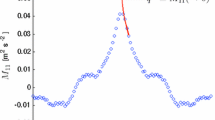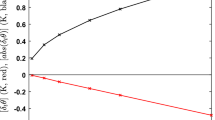Abstract
The evolution and structure of a steady barotropic nocturnal boundary layer are investigated using a higher-order turbulence closure model which includes equations for the mean quantities, turbulence convariances, and the viscous dissipation rate. The results indicate that a quasi-steady nocturnal PBL might be established in 4–10 hours after transition, depending on surface cooling rate. The latter is assumed to be constant in the model. The emphasis is on prediction of eddy viscosity, nocturnal mixing-layer depth, and the stability-dependent universal functions in the geostrophic drag and heat transfer relations. The model predictions are parameterized in the framework of the PBL similarity theory and compared with observations and results of other models.
Similar content being viewed by others
References
Arya, S. P. S.: 1975, ‘Geostropic Drag and Heat Transfer Relations for the Atmospheric Boundary Layer’, Quart. J. Roy. Meteorol. Soc. 101, 147–161.
Arya, S. P. S.: 1977, ‘Suggested Revisions to Certain Boundary Layer Parameterization Schemes used in Atmospheric Circulation Models’, Mon. Wea. Rev. 105, 215–227.
Blackadar, A. K.: 1957, ‘Boundary Layer Wind Maxima and their Significance for the Growth of Nocturnal Inversions’, Bull. Amer. Meteorol. Soc. 38, 283–290.
Blackadar, A. K.: 1976, ‘Modeling the Nocturnal Boundary Layer’, Third Symposium on Atmospheric Diffusion and Air Quality, Raleigh (Oct. 1976), pp. 46–49, Preprints, Amer. Meteorol. Soc., Boston.
Briggs, G. A.: 1977, ‘Predictions of Nocturnal Mixing Layer Parameters’, Manuscript, 40pp., ATDL, Oak Ridge, Tenn.
Brost, R. A. and Wyngaard, J. C.: 1978, ‘A Model Study of the Stably Stratified Planetary Boundary Layer’, J. Atmos. Sci. 35, 1427–1440.
Businger, J. A., Wyngaard, J. C., Izumi, Y., and Bradley, E. F.: 1971, ‘Flux-Profile Relations in the Atmospheric Surface Layer’, J. Atmos. Sci. 28, 181–189.
Businger, J. A.: 1973, ‘Turbulent Transfer in the Atmospheric Surface Layer’, in D. A. Haugen (ed.), Workshop on Micrometeorology, Amer. Meteorol. Soc., Boston, pp. 101–149.
Businger, J. A. and Arya, S. P. S.: 1974, ‘The Height of the Mixed Layer in the Stably Stratified Planetary Boundary Layer’, Adv. in Geophys. 18A, Academic Press, New York, 73–92.
Caughey, S. J., Wyngaard, J. C., and Kaimal, J. C.: 1978, ‘Turbulence in the Evolving Stable Boundary Layer’, Manuscript, 46 pp., CIRES, Univ. of Colorado / NOAA, Boulder.
Clarke, R. H., Dyer, A. J., Brook, R. R., Reid, D. G., and Troup, A. J.: 1971, ‘The Wangara Experiment: Boundary Layer Data’, Tech. Pap. No. 19, CSIRO, Div. Meteor. Phys., Melbourne, Australia, 362 pp.
Deardorff, J. W.: 1972, ‘Rate of Growth of the Nocturnal Boundary Layer’, in H. W. Church and R. E. Luna (eds.) Proc. of the Symposium on Air Pollution, Turbulence and Diffusion, New Mexico (Dec. 1971), pp. 183–190.
Delage, Y.: 1974, ‘A Numerical Study of the Nocturnal Atmospheric Boundary Layer’, Quart. J. Roy. Meteorol. Soc. 100, 351–364.
Izumi, Y.: 1971, ‘Kansas 1968 Field Program Data Report’, AFCRL-72–0041, 79 pp., AFGL, Hanscom Field, Bedford, Mass.
Izumi, Y. and Barad, M.: 1963, ‘Wind and Temperature Variations during Development of a Low-Level Jet’, J. Appl. Meteorol. 2, 668–673.
Melgarejo, J. W. and Deardorff, J. W.: 1975, ‘Revision to "Stability Functions for the Boundary-Layer Resistance Laws Based upon Observed Boundary-Layer Heights’, J. Atmos. Sci. 32, 837–839.
Nieuwstadt, F. T. M. and Driedonks, A. G. M.: 1979, ‘The Nocturnal Boundary Layer: a case study compared with model calculations’, Manuscript, Royal Netherlands Meteorological Institute, De Bilt, 35pp.
Rao, K. S. and Snodgrass, H. F.: 1978, ‘The Structure of the Nocturnal Planetary Boundary Layer’, ATDL Contribution File No. 78/9, NOAA, Oak Ridge, Tenn., 44pp.
Wyngaard, J. C.: 1975, ‘Modeling the Planetary Boundary Layer — Extension to the Stable Case’, Boundary-Layer Meteorol. 9, 441–460.
Yamada, Y.: 1976, ‘On the Similarity Functions A, B, and C of the Planetary Boundary Layer’, J. Atmos. Sci. 33, 781–793.
Yu, T. W.: 1978, ‘Determining the Height of the Nocturnal Boundary Layer’, J. Appl. Meteorol. 17, 28–33.
Zeman, O. and Lumley, J. L.: 1978, ‘Buoyancy Effects in Entraining Turbulent Boundary Layers: A Second-order Closure Study’, Proceedings of Symposium on Turbulent Shear Flows, Springer-Verlag (to appear).
Zilitinkevich, S. S.: 1972, ‘On the Determination of the Height of the Ekman Boundary Layer’, Boundary-Layer Meteorol. 3, 141–145.
Zilitinkevich, S. S.: 1975, ‘Resistance Laws and Prediction Equations for the Depth of the Planetary Boundary Layer’, J. Atmos. Sci. 32, 741–752.
Author information
Authors and Affiliations
Additional information
Affiliation with Oak Ridge Associated Universities (ORAU).
Rights and permissions
About this article
Cite this article
Rao, K.S., Snodgrass, H.F. Some parameterizations of the nocturnal boundary layer. Boundary-Layer Meteorol 17, 15–28 (1979). https://doi.org/10.1007/BF00121934
Received:
Issue Date:
DOI: https://doi.org/10.1007/BF00121934




